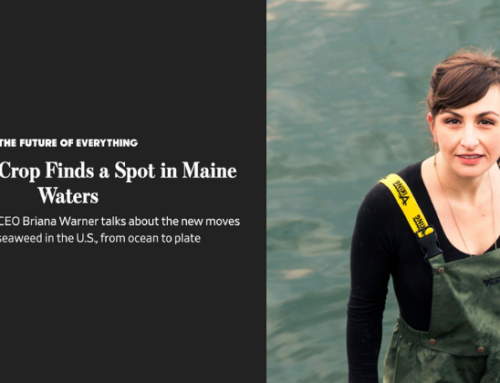Kelp Is the Healthy, Sustainable—and Delicious!—Food Experts Want Us to Eat More Of
It’s good for you and the planet.
By Kristy Del Coro, MS, RD
April 02, 2021
An ingredient that is nutrient-rich, requires zero input to grow, and tastes delicious? That almost sounds too good to be true—but kelp, a variety of seaweed, is the real deal. Whether consumed dried, fresh, pureed, fermented, pickled, steamed, or roasted, kelp may also be one of the most versatile ingredients to use in the kitchen. Move over kale, this sea-based “leafy green” deserves center stage.
Technically a brown algae (it turns bright green when cooked from the natural chlorophyll), kelp has been consumed for centuries in cold coastal areas all around the world, including in parts of Japan, China, Korea, Scandinavia, Australia, New Zealand, and more. Historically, kelp has only been available commercially at scale in dried form in the United States, but kelp can now also be easily found and purchased fresh. It’s also being incorporated into a variety of innovative packaged food products opening up more possibilities for integrating kelp into our diets on a regular basis. Most importantly, kelp is being studied for its tremendous sustainability benefits to improve the health of our planet and to diversify the income for fishing communities that are so negatively impacted by global warming.
Health Benefits of Kelp
Kelp is an incredibly nutrient-dense food, meaning it’s low in calories but packed with beneficial nutrients. At only 25 calories per 2-ounce serving of fresh raw kelp, it contains nearly 20 different measurable vitamins and minerals including iron, potassium, calcium, vitamin A, Vitamin B12, magnesium, and iodine in addition to soluble fiber, protein-building amino acids, and heart-healthy omega-3 fatty acids.
Specific amounts of these micronutrients will vary among species, growing habitats, harvest age, and processing, but all seaweed will be an excellent source of iodine and is considered one of the highest food sources of this essential mineral. And it doesn’t take much to reap the benefits: Just 2 tablespoons of dried sugar kelp (known as kombu) can provide nearly 900 percent of your daily requirements for iodine, and a 2-ounce serving of blanched fresh baby kelp provides 745 percent of the daily value. Iodine content is generally highest in freshly cut young seaweed and nearly any amount consumed will easily exceed the recommended daily value.
Why is iodine such an important mineral? Because your body does not produce it, so it must be consumed through food. Also, it’s estimated that over 2 billion individuals around the globe have insufficient iodine intake, and iodine intake in industrialized countries has fallen in recent years (including in the U.S.) Iodine is used by the thyroid gland to make thyroid hormones which impact growth and brain development, so adequate intake is especially important during pregnancy, infancy, and childhood. Iodine intake is also a nutrient of concern for those following entirely plant based diets, since it’s often found in dairy and seafood. Furthermore, with the rise in popularity of sea salt and kosher salt in cooking, there is a lower consumption of iodized salt, increasing the need to get iodine from other sources.
Kelp is also a good source of (non-dairy) calcium, vitamin B12, and omega-3 fatty acids, all of which are other nutrients of concern in plant-based diets. Finally, on top of essential vitamins and minerals, kelp contains other health-promoting anti-inflammatory compounds and antioxidants and is being studied, along with other varieties of seaweed, for its effects on blood sugar regulation, heart disease, and gut health, among other chronic diseases.
Environmental Benefits of Kelp
Not only is kelp incredibly nutritious for the body, it is recognized as a beneficial sea crop for the environment. First, kelp does not require any input to grow—no fresh water, no arable land, no fertilizers, and no pesticides—and is very fast growing. Second, research shows that kelp forests can play a huge role in removing carbon and nitrogen from the atmosphere and mitigating some of the negative effects that global warming has on our oceans. In fact, kelp forests have the potential to sequester up to 20 times more carbon per acre than land forests.
This is so important because too much of the carbon and nitrogen emitted into the air (as a result of industrialization and air pollution) gets dissolved into the ocean, causing the ocean to become more acidic, and in turn, the water less habitable for ocean plants and marine animals. The beauty of kelp is that it takes in an astounding amount of both carbon and nitrogen as it grows, removing both from the surrounding seawater, making the ocean less acidic in a “halo” effect around it. As one way to quantify this, researchers have tested mussel shells at various distances inside and outside of a kelp farm and found that the mussels grown within the kelp farm had significantly stronger shells and larger mussel meat mass as compared to those outside the farm, indicating they thrived better underneath the halo of the farm. And if kelp is not harvested and remains in the ocean, it does have the potential to sequester carbon permanently, or at least for centuries. Maine-based company Running Tide is actually piloting a project to sink kelp crops in the deep sea as an attempt to remove carbon from the atmosphere.
Although not kelp, another type of seaweed is also being studied for its impact on reducing methane output from cows. Early research indicates that replacing less than 0.5 percent of a cow’s feed with a specific variety of red seaweed known as Asparagopsis reduces their methane production by up to 98 percent. This finding has the potential to make a significant impact on reducing the harmful greenhouse gas emissions associated with cattle that contribute to global warming. Why not feed this to all cattle worldwide? There is currently no large-scale commercial production in place to provide a supply to meet the demand but organizations such as Greener Grazing are trying to change this.
While much of this research is still ongoing and relatively nascent, it is clear that kelp is a win-win for the environment and has the potential for tremendous benefits to our climate.
Kelp Offers Community Benefits, Too
In addition to environmental benefits, kelp has tremendous potential to benefit local economies and fishing communities. Atlantic Sea Farms, founded in 2009 as Ocean Approved, works with Maine fishermen to diversify their incomes in the face of climate change.
According to the Natural Resources Council of Maine, the Gulf of Maine happens to be warming faster than 99 percent of the world’s oceans, and fishermen have been directly impacted due to its negative effects on valuable commercial species such as lobster, shrimp, clams, oysters, and groundfish. Warming waters are disruptive for the entire marine ecosystem—it causes some seafood to be more susceptible to disease, negatively affects their food supply, impacts breeding cycles, and increases the prevalence of predatory species—all of which affect the stock levels of many commercial fish species. Regulations put in place to help conserve some of these species means that fishermen can no longer rely on these species for their businesses. For example, Maine lobstermen long relied on shrimp during their off season as an alternative source of income, yet Maine shrimp fisheries have been closed since 2014 to help rebuild stock levels.
Global warming also causes fish and shellfish species to start migrating to colder deeper waters farther out from shore, meaning boats have to travel further to get a decent catch. This means more money is spent on gas (resulting in lower profit margins), which again takes away from a fisherman’s income. Briana Warner, CEO of Atlantic Sea Farms, explains that “kelp farming gives fishermen another source of income during the off-season that can utilize their existing infrastructure” while also benefiting the environment and bringing a nutritious product to market for consumers. “Kelp is hope for our coast,” she adds. Furthermore, nurturing the growth and expansion of kelp farms in the U.S. increases the domestic supply of kelp, as over 98 percent of the edible seaweed on the market is grown in Asia.
How to Start Incorporating Kelp Into Your Diet
The most common variety of kelp found in supermarkets is sugar kelp, which you’ll find dried as kombu. (Nori, dulse, wakame, and hijiki are other varieties of seaweed available, but are not the same species as kelp).
While most seaweed available in supermarkets is sold in dried form and imported from Asia, Atlantic Sea Farms has opened up the market for domestically grown fresh kelp and kelp products at scale. Its kelp is sustainably rope-grown in the cool, clean waters of Maine, then blanched, cooled, and frozen to maintain a long shelf life without any need for rehydrating. It’s available as ready-cut kelp or pureed fresh kelp cubes in addition to a line of fermented products. According to Warner, “blanching the kelp also removes the deep fishy flavor so it tastes like the freshness of the ocean without the fishiness that is less desirable.” Blanching also brings out the bright green color without any additives (green chlorophyll is the only color pigment that remains after heating), helps maintain its nutrients, and preserves the clean, crisp, ocean flavor of fresh kelp that changes when dried. The company farms two varieties both native to the Gulf of Maine: Sugar kelp and ribbon-like skinny kelp. Both are harvested young to maintain their tender texture.
Kelp is being incorporated in a variety of retail products found in stores or available online, including gut-friendly fermented seaweed salads like Atlantic Sea Farms Sea-Chi, Barnacle Foods Kelp Pickles, and Salsa Verde. You can also find dried kelp in sheets, flakes, or granules for sprinkling at many specialty grocery stores and also in novel ways such as noodles.
Tips for Buying Kelp
- Seaweed can act like a sponge, taking up heavy metals that may be in the environment, so look for sources from clean waters. Many companies will regularly test their products for heavy metals, pesticides and herbicides, petroleum residues, and radioactivity, and will make this claim on the website or product label. Some brands may also go through organic certification if available, another good indicator the product is clean and safe.
- Look for seaweed free of additives, such as artificial coloring or flavoring.
- Think about your cooking application to determine which type and form is the best fit.
- Dried kelp will expand when rehydrated and has a more concentrated flavor than fresh, so keep this in mind when cooking with kelp.
Link to Read More: https://www.realsimple.com/food-recipes/recipe-collections-favorites/popular-ingredients/kelp-benefits?mc_cid=6cd4ae5ea3&mc_eid=99551a6490






